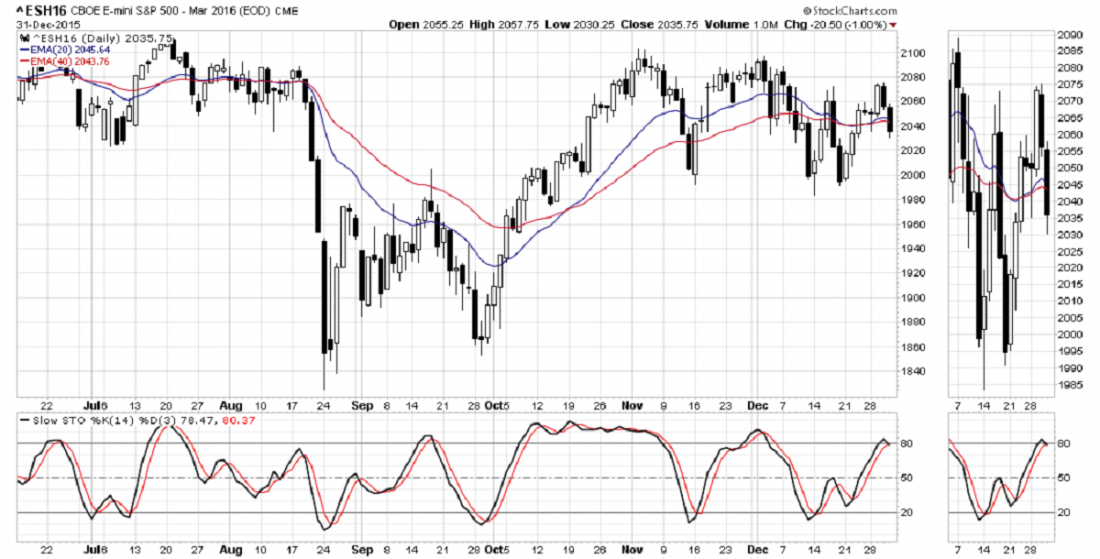“Making predictions is tough, especially about the future.” – Yogi Berra
We’ve been browsing through the usual New Year’s predictions from the financial institutions over the holidays, more for amusement than enlightenment, and after weighing all the careful forecasts about what lies ahead in 2016, we’ve come to the same conclusion we reached last year: Nobody knows nothin’.
This isn’t to dump on the analysts who put this stuff out. To a man (and woman) they are smart people, devoting countless hours to examining the finest details of the markets and the economy, devising brilliant theories to make sense of the data they collect. And most of the time, with rare exceptions, they are wrong.
The consensus for the year 2015, published a year ago, was for the S&P500 to end the year above 2,200; it opened on January 1, 2015 at 2058.90 and closed December 31 at 2043.94, 15 points below the open and 160 points below the consensus.
So what’s the consensus for 2016? Almost exactly the same. The 10 financial powerhouses that said we would end last year around 2,200 are now saying we will end this year around – wait for it — 2,195. Same call, new date.
The problem is that something always happens, and the something always comes as a surprise. The most significant economic development last year was the devastating crash in commodity prices, epitomized by the 60% drop in the price of oil. You read anything about that last January? Me neither.
The second issue is the everlasting optimism that permeates the Wall Street prediction machine. All of the Big 10 institutions say the S&P500 will at least end the year above 2100; the more adventurous say above 2,300. None acknowledge any possibility that the market might go down in 2016. They differ in their predictions about how far up it will go; nobody even hints that it might go down.
But there are lots of reasons to be cautious about US equity markets, and the case for the S&P500 ending the year at 1850 is at least as strong as the case for 2,200.
For example, the market breadth is extremely narrow. Of the S&P 500 components, 301 were down 10% or more from their 52-week highs and 175 were off by at least 20% through the end of 2015. The index would be down substantially for the year without the dazzling performance of a handful of tech stocks that is eerily reminiscent of the “nifty fifty” from a previous century. Go look them up if you want to see what happens next.
We see this market as balancing on the edge at this point. We’ve come through a consolidation year of lower highs that looks like a long, slow rounding top forming after an unusually long Bull Run. The world is awash in debt even as overseas markets are dropping fast, and the Fed has just raised interest rates and is promising to raise them more. It doesn’t smell right.
But so far nothing has broken. Every sell-off has been met by new buyers, and the cascading waterfall declines after August have more-or-less recovered … except that they are still making lower highs. A bull market typically gives us a blow-off top before it lies down and dies. That hasn’t happened yet, unless you count the phenomenal (and suspect) performance of the FANGs that are holding the indices up when everyone else is slumping.
We aren’t calling for an imminent crash. We don’t know what will happen, although you can read our calculated guesses in detail at www.naturus.com.
But nobody else knows either. And there are enough signs of trouble ahead to make us cautious. It’s time to be nimble, and start checking the exits. Just in case.
Today
Having told you that nobody knows nothing, we are now going to make a few cautious and conditional calls on the S&P500 mini-futures (ES). We are aware of the irony. But our calls are much more modest and much shorter, and we don’t mind identifying them as informed guesses. And you won’t have to wait a year to find out if we’re wrong.
We are trading the SP500 mini-futures, symbol ESH6, and 2045-48.50 will be the first zone we watch today (Monday). The ES was trading down about 15 points in the early overnight trading, but it may recover by morning and move the ES further after the market opens, up to 2057-55 or higher up to 2065-62.50.
But ES also could go low first if it fails to move above 2045-48.50. The Dec 18 closing level is 1992. That’s where the price was when the big traders left for holidays; this level may well be retested again when they return.
Major support levels: 2000.50-1998.50, 1990.50-92.25, 1975-72, 1962-58
Major resistance levels: 2068.50-2069.50, 2075-78, 2088-95.50
Get Free Detailed market analysis from Naturus.com here: Naturus market analysis
Chart: ESH6 Daily chart Dec. 31, 2015





